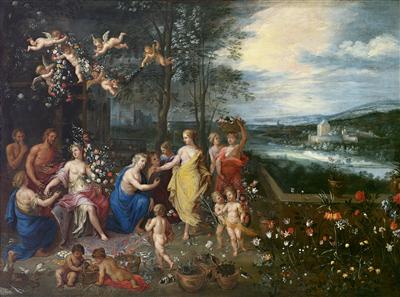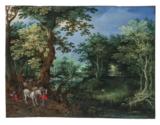Studio of Jan Brueghel I

(Brussel 1568–1625 Antwerp)
Allegory of Spring;
Allegory of Summer;
Allegory of Autumn;
Allegory of Winter,
bears date MDCXVI on the book depicted in the Allegory of Winter,
oil on canvas, each 80.2 x 106.5 cm, framed (4)
Provenance:
(possibly) formerly with Chaucer Fine Arts Gallery, London;
Private European collection
Literature:
possibly K. Ertz, Jan Brueghel der Ältere (1568–1625): kritischer Katalog der Gemälde, Lingen 2008–2010, Vol. 3, p.1090, ill. 521/1, 522/1, 523/1, 524/1
The present works are based on a series of the seasons by Jan Brueghel the Elder and Hendrick van Balens dated 1616, currently in the Staatsgalerie in Neuburg an der Donau (see literature, cat. no. 521-524), and which are possibly identical to the copies by an “unidentified painter“ mentioned by Ertz with reference to the Neuburg paintings (see literature).
Following the natural order of Spring, Summer, Autumn and Winter, the paintings create a unified whole with a closed, formal composition, bordered on each of the outside edges of the allegories of Spring and Winter. In his presentation of the seasons, Brueghel adheres to Cesare Ripas Iconologia. Spring is symbolised by Flora with flowers in her arms, crowned with a wreath of flowers. The plate of eggs in the middle ground is an allegory of fertility. Summer is shown in the form of Ceres with ears of corn in her hair; the abundance in the foreground contrasted with the work of harvesting in the background. Bacchus and the group drinking wine represent Autumn. However, for Winter Brueghel and Balen move away from Ripa’s iconographic concept, with Venus in Vulcan’s forge, instead adopting a profane variation on the theme: an old man holding a feast at a table.
In addition, in each painting a girl is depicted as a sign of the Zodiac, allegories of the months, with the Zodiac signs running from left to right (only the sign of Cancer is missing in the present works). It is the winter scene which is of particular art historical interest, revealing the 17th century eating habits and table decorations of high society. Janus, shown as the two-headed man holding a key in the hand behind the column, symbolises the transition into the New Year, and the woman with bared breast, Luxuria, the evil and the corrupt. The old man also illustrates winter as the season of dying and death.
In contrast to the Neuberg originals, the present works are somewhat less detailed, the numerous, lightly clad figures draped in additional robes. The Neuburg Allegory of Spring differs from the present work with the depiction of a satyr in place of a monk and nun on the left edge of the painting, and the missing open Bible in the left foreground. In the Allegory of Sommer, the girl’s basket on the left side of the painting is missing. Contrary to the inscription on the opened book in the left foreground of Allegory of Winter, Ertz does not believe these works date to the early 17th century, and instead places the artist in the circle around Balthasar Beschey (1708-1776).
17.04.2013 - 18:00
- Dosažená cena: **
-
EUR 97.900,-
- Odhadní cena:
-
EUR 80.000,- do EUR 120.000,-
Studio of Jan Brueghel I
(Brussel 1568–1625 Antwerp)
Allegory of Spring;
Allegory of Summer;
Allegory of Autumn;
Allegory of Winter,
bears date MDCXVI on the book depicted in the Allegory of Winter,
oil on canvas, each 80.2 x 106.5 cm, framed (4)
Provenance:
(possibly) formerly with Chaucer Fine Arts Gallery, London;
Private European collection
Literature:
possibly K. Ertz, Jan Brueghel der Ältere (1568–1625): kritischer Katalog der Gemälde, Lingen 2008–2010, Vol. 3, p.1090, ill. 521/1, 522/1, 523/1, 524/1
The present works are based on a series of the seasons by Jan Brueghel the Elder and Hendrick van Balens dated 1616, currently in the Staatsgalerie in Neuburg an der Donau (see literature, cat. no. 521-524), and which are possibly identical to the copies by an “unidentified painter“ mentioned by Ertz with reference to the Neuburg paintings (see literature).
Following the natural order of Spring, Summer, Autumn and Winter, the paintings create a unified whole with a closed, formal composition, bordered on each of the outside edges of the allegories of Spring and Winter. In his presentation of the seasons, Brueghel adheres to Cesare Ripas Iconologia. Spring is symbolised by Flora with flowers in her arms, crowned with a wreath of flowers. The plate of eggs in the middle ground is an allegory of fertility. Summer is shown in the form of Ceres with ears of corn in her hair; the abundance in the foreground contrasted with the work of harvesting in the background. Bacchus and the group drinking wine represent Autumn. However, for Winter Brueghel and Balen move away from Ripa’s iconographic concept, with Venus in Vulcan’s forge, instead adopting a profane variation on the theme: an old man holding a feast at a table.
In addition, in each painting a girl is depicted as a sign of the Zodiac, allegories of the months, with the Zodiac signs running from left to right (only the sign of Cancer is missing in the present works). It is the winter scene which is of particular art historical interest, revealing the 17th century eating habits and table decorations of high society. Janus, shown as the two-headed man holding a key in the hand behind the column, symbolises the transition into the New Year, and the woman with bared breast, Luxuria, the evil and the corrupt. The old man also illustrates winter as the season of dying and death.
In contrast to the Neuberg originals, the present works are somewhat less detailed, the numerous, lightly clad figures draped in additional robes. The Neuburg Allegory of Spring differs from the present work with the depiction of a satyr in place of a monk and nun on the left edge of the painting, and the missing open Bible in the left foreground. In the Allegory of Sommer, the girl’s basket on the left side of the painting is missing. Contrary to the inscription on the opened book in the left foreground of Allegory of Winter, Ertz does not believe these works date to the early 17th century, and instead places the artist in the circle around Balthasar Beschey (1708-1776).
|
Horká linka kupujících
Po-Pá: 10.00 - 17.00
old.masters@dorotheum.at +43 1 515 60 403 |
| Aukce: | Obrazy starých mistr? |
| Typ aukce: | Salónní aukce |
| Datum: | 17.04.2013 - 18:00 |
| Místo konání aukce: | Wien | Palais Dorotheum |
| Prohlídka: | 06.04. - 17.04.2013 |
** Kupní cena vč. poplatku kupujícího a DPH
Není již možné podávat příkazy ke koupi přes internet. Aukce se právě připravuje resp. byla již uskutečněna.
Další objekty umělce
-

Odhadní cena:
EUR 80.000,- do EUR 100.000,-
Všechny objekty umělce
